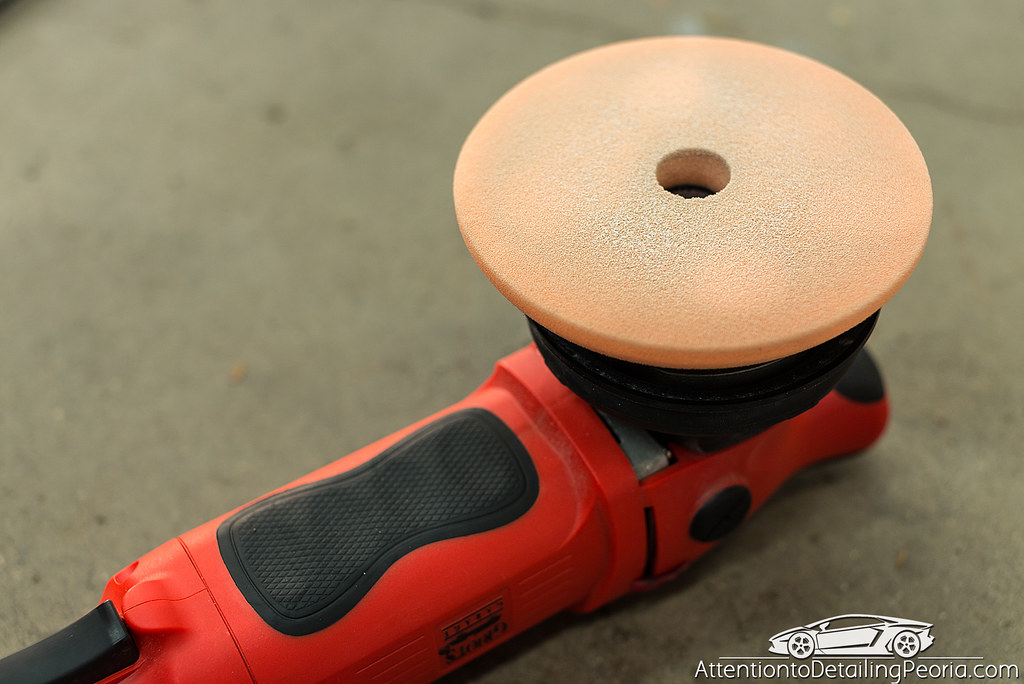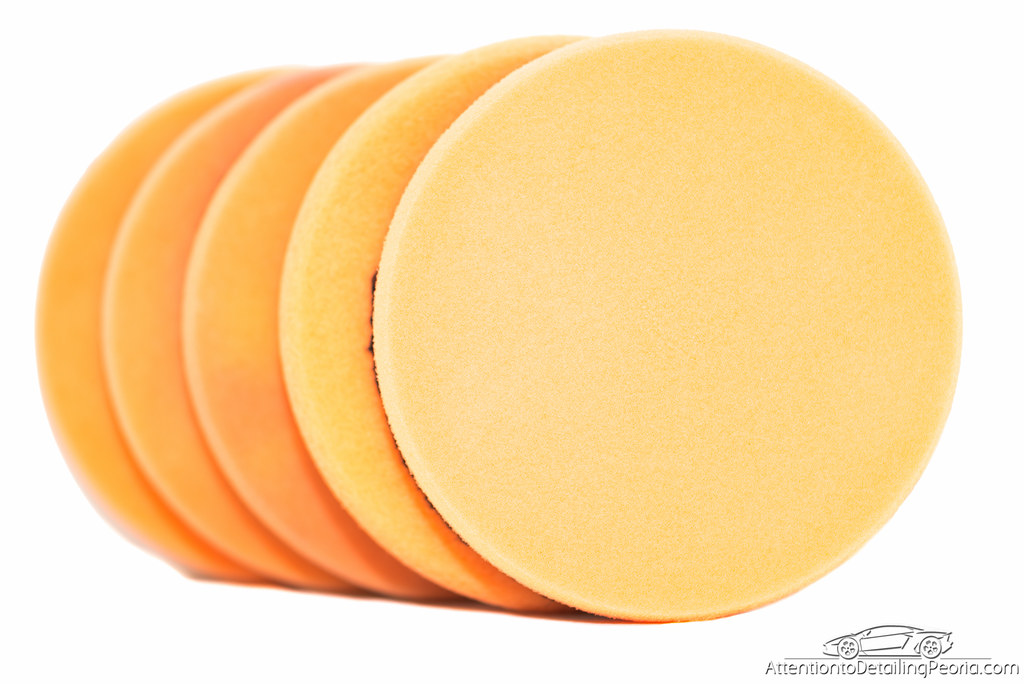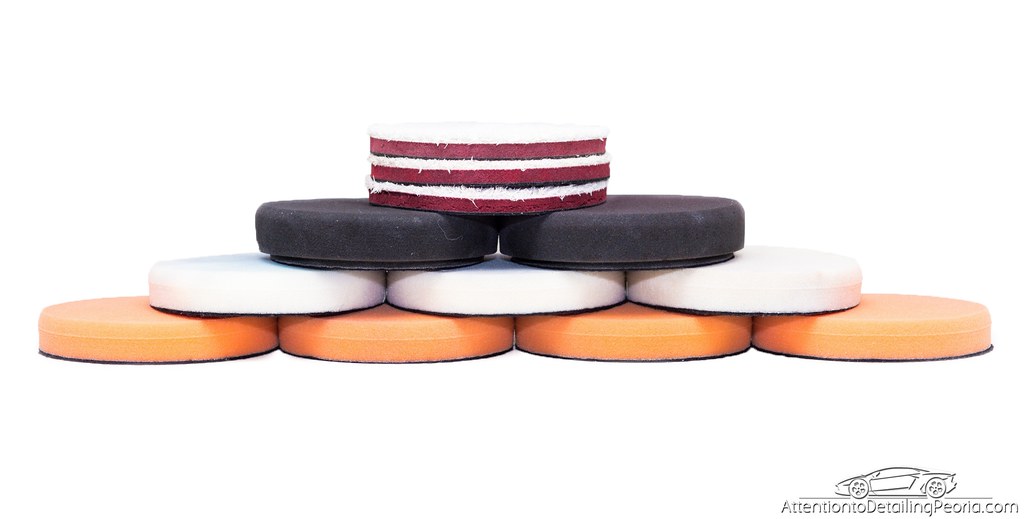Polishing Pads: How Many Do I Need?
by Zach McGovernA decision that all amateur detailers have to make is how many pads they need to buy. This is a question I am asked quite often, and something that is worth discussing in more detail. Many consumers frequently assume that just one of each type of pad is enough to properly complete a paint correction job, but if you’ve gone through the process before, you know this is far from the truth.
Why Do I Need Multiple Pads?
During the paint correction process, compound/polish, dirt, and paint will begin to accumulate on the face of the pad. This contamination needs to be removed regularly to help maintain a clean pad face and produce consistent results, however there comes a time when the pad is too dirty to ‘clean on the fly’. When the pads reach this point, the performance is reduced, dusting will likely increase, and it may create other frustrations which hinder your progress. In this instance, it is easiest to switch to a new pad, otherwise the dirty pad must be thoroughly washed, rinsed, and dried before it is ready for use again. More pad cleaning information can be found in this great article by Ivan Rajic.

How Many Pads Do I Need?
The cutting/compounding process will result in more material being removed and therefore more dust and residue will be present. This often means more pads will be required for compounding than polishing.
In general, I recommend at least 3 of each type of pad to allow for best results. Some jobs may require more if the vehicle is in considerably poor shape. We tend to switch pads very regularly, and therefore go through quite a few pads for each job, but it helps to ensure we are producing uniform results throughout the job.
If you spread the job over multiple days you could get away with fewer pads, but this will require you to wash all of your pads at the end of the day and ensure they are dried so they are ready for use the next morning. In general, I highly recommend buying more pads than you think you may need. It never hurts to have a spare, or two.

Which Pads Should I Buy?
I often recommend microfiber cutting pads, orange light cutting pads, white polishing pads, and black finishing pads (or similar options from other brands) as the basic pads to produce great results on almost every type of vehicle when paired with appropriate products. This variety of pads ranges from aggressive microfiber cutting pads to soft foam finishing pads, and therefore will allow for a wide range of work to be done. Remember that the functionality of polishing liquids can be manipulated with a different pad choice. This is discussed in my article about Pairing Products and Pads.

Before you start your next project, be sure you’ve got enough (or more than enough) pads to get the job done!









2 blue foam and 2 Wool pads plus 10 6″ orbital bonnets. If I have to explain further, your in the wrong business !
I think it is safe to say we have a difference of opinion on this topic. Thanks for reading
Agree. Boat and RV detailing must not be as detail oriented
Agree, in fact, Boats and RV’s should never be detailed to begin with.
Great write up Zach!!!!…very helpful!!..love how you put little links to other very helpful write ups as well!! Thanks brother!!
Happy to help, thanks for reading!
Thoroughly incomplete assessment in comparison to usually very high quality write ups here on DI. To say “it never hurts to keep a few extra around” completely misses the point! At $10 a quality pad during a 3-4 stage polish… heck yeah it does!!! Then to completely ignore the relevance or impact of new pad surface textures such as egg crate or especially hex logic is disappointing. This is a an amateur article with very little depth or analysis.
Hi Dave – thank you for your feedback. It seems I may have not clearly identified the intended audience of this article, so allow me to further explain the thoughts and information in this article. As the opening sentence points out… “A decision that all amateur detailers have to make is how many pads they need to buy”… this article is meant to capture the attention of the amateur detailer. The guy who is looking to buy his first DA set up or is looking to perhaps invest in some more pads because he only has a couple. In fact, some of the most common questions I am asked is “How many pads do I need?”, “Why do I need more than one of each pad?”, “Can I clean my pads?”… so this article was meant to help answer some of these questions.
The specific statement you refute regarding “it never hurts to have a spare, or two” is something I will stand by strongly. Pads will wear out and fail over time. This is often unpredictable. If you only have the exact amount of pads you think you need, what do you do when you’re in the middle of a job and you have a pad fail? I would want to ensure I have an extra so that I can finish my job… and at just $10, as you put it, it is no financial burden relative to the investment already being made in tools and products.
The basic pad recommendations I gave are also something I will stand by. While there are many types of foam pads which vary in terms of cell structure and texture, an amateur detailer will likely see no added benefit. This recommendation is based on years of personal experience with paint correction work. While we do utilize other pads, the products I recommended are the ones we still reach for most often and ones I am confident will provide fantastic results for anyone.
Again, this article was aimed at the novice detailer to help them decide how many pads to buy and perhaps provide some insight onto which pads might be helpful to achieve their goals. If you would like a more in depth pad article, perhaps that is something we can do in the future. Thanks again.
I have to agree with Zach. I wouldn’t call myself an amateur but my ‘go to’ pads are usually starting with the MF cutting & finishing with the orange light cutting or white polishing. I have had some very good results on softer paint taking extra time using the orange pad with Megs PRC. I do also have a range of other pads to choose from depending on the situation. What gets me is when someone complains about the price of pads! Here in New Zealand we have very limited choice & usually pads start from around $23 each. There are a few of us that purchase our products from America as it’s not just pads we are limited on here. So when we do buy from overseas we always look out for deals & buy the package deals. As for having one or two spare, my MF pad stash is huge!
Zach. Need your help. I am going to order a porter cable 7424 xp and need to find the pads I need to use. I will be using them on plastic engine parts. They will be painted and clear coated, so I just want to buff to a shine. This is what I was advised to use.
Meguiar’s 105 ultra cut compound with a porter cable orange pad
Meguiar’s 205 ultra finishing polish with a porter cable white pad
Meguiar’s ultimate polish with a porter cable grey pad
Then dried buffed everything with a porter cable red pad
I didn’t use a wax on it as I want the paint to cure. For that I use Meguiar’s yellow #26
Does that make sense and if so, what pads do I need? I couldn’t find any porter cable pads and there were multiple vendors with the same color pads so just need some direction here. This is my first rodeo.
Thanks,
Matt
Hi Matt – I assume the pads you’re referring to are Lake Country pads. Orange Light Cutting Pad, White Polishing Pad, Black (or grey) finishing pad, and red ultra fine finishing pad.
I would generally agree with the process aside from the dry buffing… I would always recommend using a polishing liquid on your pad and not simply dry buffing with a bare pad on a surface. This 4 step process may be overkill… often times you will find that the first 2 steps (compound on orange pad and then 205 on white pad) will yield amazing results. You will have to do some testing to determine the exact process you need to produce the best results.
I don’t know about the pads, as what he had was exactly what I described above. I will assume it is Lake County. Thanks for the info.
What about the size of the pad? Is 5.5 okay to use for this, or 6.5 or 4?
Thanks
Pad size is dictated mostly by the task at hand. If you’re working on a larger, flat surface, then you can use larger pads. If you are working on smaller, more intricate areas, then smaller pads will be needed.
Noob here..do I buff a dried wax with the black pad or should I hand remove with a microfiber towel ?
Hi Craig – Dried waxes and sealants need to be removed with a microfiber towel or bonnet, not a foam pad.
Thanks for your time replying.
Zach, thank you for making the effort to educate us. In the future, when talking about foam pads or other products, could you specify the manufacturer. I’m assuming different companies use different colors, and have different aggressiveness. I’m assuming a Griot’s red pad has a different “grit” than a lake country red pad. Please enlighten us. thanx wayne
Hi Wayne – I provide links to every product mentioned in all of my articles to avoid any confusion. You will find the same in this article… all pads mentioned have links directly to the products I am referring to. In the future, I will do my best to specify more clearly in the article though. Thanks for reading!
Hi Zack,
thank you for educating us about everything in detailing.
God bless you my brother.
Hi Zach,
I have been looking around on the website and have not been successful in locating an answer. So, rather than you having to explain/answer, if there is a link, that would be great too.
My question is regarding cleaning the pads. I use Snappy’s, and that works well most of the time but definitely not with pads that contain Menzerna Power Lock Sealant. The pads do not get clean, and the sealant just gets slimy in/on the pads. I have used some of the D1 Microfiber Detergent and that has helped but the pads are still not clean.
Any help would be appreciated.
Thanks!
Rick
Hi Rick – I have never been successful in removing sealants like Power Lock from pads. I power wash our pads after scrubbing them with all purpose cleaner, and it helps, but they never get completely clean. My answer to you is to make a pad or two dedicated sealant pads and leave it at that
How long does a polish/wax last after applied on car? 3-6 months? Or less?
A polish does not “last” as it is not something that remains on the surface of a vehicle after use. A polish is a liquid containing microabrasive particles that when paired with specific pads and tools can be used to level paint surfaces to remove superficial defects and therefore enhance gloss and clarity. The residue is wiped away and completely removed from the surface of the vehicle after use. Some polishes may fill in minor defects due to the oils/makeup of the polish, but this should be removed with a solvent in order to properly inspect the results of the polishing process. A polish does not provide protection for your paint.
A pure wax is a temporary barrier between your paint and the elements that can also help to fill in superficial defects to temporarily enhance the gloss of the surface. A wax should typically be reapplied quite often, sometimes as soon as just a couple of weeks, and possibly up to a month or two. A more durable paint protection option would be a polymer sealant or ceramic nano coating.
Please let me know if you have any questions
Bought a DA polisher and want to use NuFinish (only) all-in-one polish on my car. What’s a good pad for this limited application?
Hello Zach,
I will be detailing a 1968 very soon. There are wetsanding marks all over the place so I will be doing a two step polish. If the paint allows it, I will be cutting with microfiber pads.
In your experience how many pads do you think I will go through on this size vehicle? I will regularly clean the pads throughout the process (blow off with compressed air after each section).
Thanks!
I meant to say 1968 Plymouth Road Runner.
Hi Ian – as many as your budget allows. If you are working professionally you should build up quite a collection of pads. If you are an enthusiast and are working on a more restricted budget you can complete the job with only a few of each pad, but you will just need to spend more time ensuring they are thoroughly cleaned.
How did the Road Runner turn out ?
Hi Zach,
I have one Lake country red pad dedicated for applying my favorite sealant. When I finish applying sealant I have been putting the pad away in a Ziploc bag without attempting to clean it. The product does not dry on the pad. Would you recommend I continue this process or should I be making an attempt to clean the pad after use. Thanks
Hi Arthur, I would still personally clean it out as I do not know if a product can dry out in/on a pad or if dirt or anything else can become embedded in the pad. I just find it to be very quick and easy to clean out the pad once you are finished and then store it for future use afterwards.